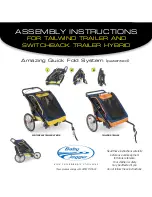
EN
EN
ATOM & ATOMS
USER MANUAL
USER MANUAL
ATOM & ATOMS
35
34
3.3 Assistance Modes of the Pedal Assistance System
There are multiple power assistance modes available.
Select the power mode, AUTO, BOOST, SPORT, ECO +, ECO and NO ASSIST, depending on what best suits
your cycling conditions.
See the “DISPLAY PANEL” section to find out how to switch between assistance modes.
AUTO
Use when you want to obtain gradual power.
BOOST
Use when you want to get maximum power from the system.
SPORT
Use when climbing difficult terrains.
ECO +
Use when you want a more comfortable ride, e.g. when climbing a steep hill.
ECO
Use when you want to travel as far as possible.
NO ASSIST
Use when you want to travel without assisted power. You can continue to use the other
functions of the display panel.
3.4 Range of the Pedal Assistance System
The range of the system will vary, depending on the following riding conditions, among others:
•
Frequent starts and stops.
•
Gear ratio of the drivetrain.
•
Numerous steep slopes.
•
Poor road conditions.
•
Transporting heavy loads.
•
Cycling into a strong headwind.
•
Low ambient temperature.
•
Deteriorated battery.
•
When using the light (only applicable to models equipped with battery-powered lights).
•
If the bicycle is not in a suitable condition, e.g. low pressure in the tyres, insufficient lubrication of the chain
or a brake not fitted correctly.
3.5 Starting Pedalling
Before resting your feet on the pedals, you must sit on the seat and hold the handlebar firmly. Special care
should be taken if you start pedalling when using a high assistance mode (BOOST mode, or SPORT mode),
as the motor will respond with maximum thrust and you may lose control. To facilitate acceleration, the motor
provides an additional initial thrust as soon as you start pedalling. So minimal force is necessary to put the
bicycle in motion, helping you to join the traffic quickly and safely.
WARNING
Start pedalling with a short gear ratio (higher gears) and low assistance mode
(ECO mode). As well as providing greater control and safety on the bicycle,
it requires less energy consumption and, therefore, ensures a longer range.
Please note that starting with a higher assistance mode (ECO +, SPORT and
BOOST modes) may put the user's safety at risk.
WARNING
When the user pushes the bike while walking alongside it, they must make
sure that the system is disconnected.
4. DISPLAY PANEL
4.1 Overview of the Display Panel
Central Display Panel with a screen located in the centre of the handlebar, with a remote control located on the
left side of the handlebar:
1.
POWER button.
2.
(+) button.
3.
(-) button.
4.
Lights indicator.
5.
Bicycle instant speed indicator.
6.
Pedal assistance mode indicator colour.
7.
Range indicator.
8.
Battery level indicator.
9.
Bicycle secondary information indicator.
10. Error indicator
NOTE
The range is calculated based on the riding conditions during the last
kilometre and the remaining capacity of the battery.
4.2 Display Panel Operation
4.2.1. Switching the Pedal Assistance System On and Off
The pedal assistance system is turned on by holding down the POWER
button for 3 seconds. The pedal assistance system is turned off by holding
down the POWER button again for 3 seconds.
The bicycle can be used normally without any type of assistance.
WARNING
After turning the system on, make sure that you do not start riding without
checking the assistance mode. By default, it starts with the assistance mode
selected before it was last switched off.
NOTE
Wait for 3 seconds after turning on the system before you start applying
pressure on the pedals. During this 3-second period, the assistance system is
starting up and calibrating the torque sensor. Otherwise, if you press the pedal
beforehand, this may weaken assistance and error 14 may even be displayed
on the screen (see Troubleshooting section). To fix this, you should reboot the
system without applying pressure on the pedals for a period of 3 seconds.
Remote Control
3
1
2
Central Screen
7
10
9
6
5
4
8
3 sec
Summary of Contents for EMOTION ATOM
Page 10: ...ES ES ATOM ATOMS MANUAL USUARIO MANUAL USUARIO ATOM ATOMS 19 18...
Page 11: ...ES ES ATOM ATOMS MANUAL USUARIO MANUAL USUARIO ATOM ATOMS 21 20...
Page 23: ...EN EN ATOM ATOMS USER MANUAL USER MANUAL ATOM ATOMS 45 44...
Page 35: ...FR FR 69 68 ATOM ATOMS MANUEL DE L UTILISATEUR MANUEL DE L UTILISATEUR ATOM ATOMS...
Page 48: ...DE DE ATOM ATOMS BENUTZERHANDBUCH BENUTZERHANDBUCH ATOM ATOMS 95 94...
Page 61: ...IT IT ATOM ATOMS MANUALE UTENTE MANUALE UTENTE ATOM ATOMS 121 120...
















































